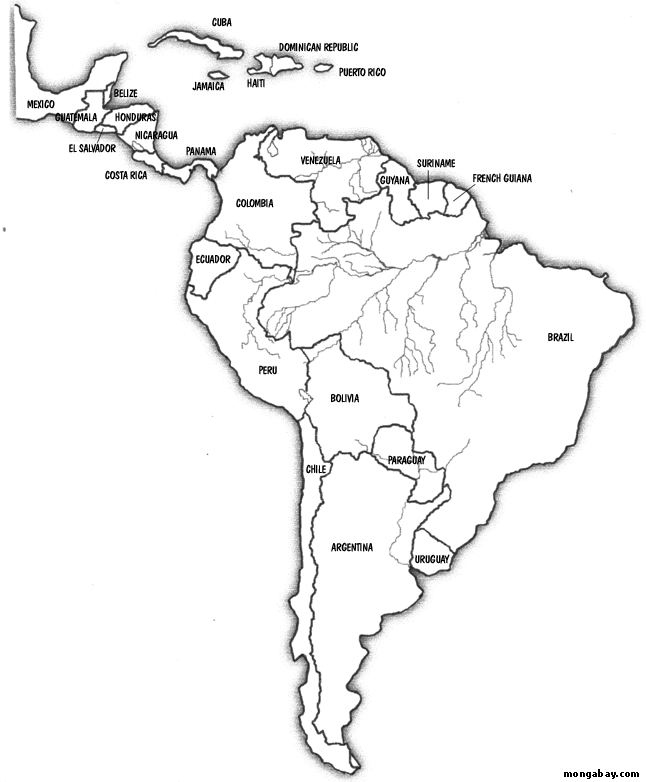NEOTROPICAL REALM
Please note, this page is not longer being updated. For more recent information, please see news.mongabay.com and use the search function to find the country feed. For more up-to-date data on forest cover and loss, check out Global Forest Watch.
South and Central America hold the bulk of the world's remaining tropical rainforests. More than 97 percent of this region's forests are found in South America, including the world's largest rainforest, the Amazon.
Threats
 |
In the Caribbean, very little natural tropical forest cover remains. Between 2000 and 2005, forest cover actually expanded in the Caribbean due to the increase in plantation cover. However, primary forest cover still declined due to clearing for development and small-scale agriculture on the part of poor farmers.
Central America had the highest deforestation rate of any region in the world over the past five years. Much of this clearing came from subsistence activities and agricultural schemes, though illegal logging is a problem in the region. Overall, Central America lost 19 percent of its forest over between 1990 and 2005. The good news is that deforestation rates are slowing.
Outlook
The outlook for the rainforests of South America is better than that of Africa because of heavy pressure by outside environmentalists and an increasingly ecologically minded, educated populace. A fair amount of land is afforded some sort of protection—though not always effective against illegal exploitation—and local projects promoting sustainable management while benefiting locals are on the rise. Several governments, including those of Brazil and Costa Rica, have passed policies to enhance protection of forests. Many Neotropical countries have developed eco-tourism as a means to generate revenue to protect forests. Costa Rica has entered into a unique bioprospecting contract with an American pharmaceutical company (Merck), and it appears that others may soon follow suit. The use and export of non-wood forest products (NWFPs) is increasing, though it still plays a minute role in trade in comparison to timber, oil, and minerals extracted from rainforest lands. Funding of large, damaging hydroelectric projects appears to be on the decline as funding agencies move to support smaller, more effective projects. Nevertheless, the forests of the Neotropical realm are facing tremendous challenges from numerous development threats.
Profiles:
Belize, Bolivia, Brazil, Caribbean islands, Colombia, Costa Rica, Ecuador, El Salvador, French Guiana, Guatemala, Guyana, Honduras, Mexico, Nicaragua, Panama, Peru, Suriname, and Venezuela.
Overview:
| Total land area | 2005 | 2005 | Total deforestation 1990-2005 | Loss of primary forest 1990-2005 | ||||||||||
| Country | (1000 ha) | (1000 ha) | % of total land area | (1000 ha) | % of total land area | % of 1990 forest cover | % of 1990 primary forest cover | |||||||
| Belize | 2,296 | 1,653 | 72.5 | 612 | 26.7 | 0.0 | 0.0 | |||||||
| Bolivia | 109,858 | 58,740 | 54.2 | 29,360 | 26.7 | -6.5 | -6.5 | |||||||
| Brazil | 851,488 | 477,698 | 57.2 | 415,890 | 48.8 | -8.1 | -9.7 | |||||||
| Colombia | 113,891 | 60,728 | 58.5 | 53,062 | 46.6 | -1.2 | -1.5 | |||||||
| Costa Rica | 5,110 | 2,391 | 46.8 | 180 | 3.5 | -6.7 | -29.4 | |||||||
| Ecuador | 28,356 | 10,853 | 39.2 | 4,794 | 16.9 | -21.5 | 0.0 | |||||||
| El Salvador | 2,104 | 298 | 14.4 | 6 | 0.3 | -20.5 | 0.0 | |||||||
| French Guiana | 9,000 | 8,063 | 91.8 | 7,701 | 85.6 | -0.3 | -2.6 | |||||||
| Guatemala | 10,889 | 3,938 | 36.3 | 1,957 | 18.0 | -17.1 | -17.0 | |||||||
| Guyana | 21,497 | 15,104 | 76.7 | 9,314 | 43.3 | 0.0 | n/a | |||||||
| Honduras | 11,209 | 4,648 | 41.5 | 1,512 | 13.5 | -37.1 | 0.0 | |||||||
| Mexico | 195,820 | 64,238 | 33.7 | 32,850 | 16.8 | -6.9 | -15.3 | |||||||
| Nicaragua | 13,000 | 5,189 | 42.7 | 1,849 | 14.2 | -20.6 | 0.0 | |||||||
| Panama | 7,552 | 4,294 | 57.7 | 3,023 | 40.0 | -1.9 | -18.4 | |||||||
| Peru | 128,522 | 68,742 | 53.7 | 61,065 | 47.5 | -2.0 | -2.9 | |||||||
| Suriname | 16,327 | 14,776 | 94.7 | 14,214 | 87.1 | 0.0 | 0.0 | |||||||
| Venezuela | 91,205 | 47,713 | 54.1 | - | n/a | -8.3 | n/a | |||||||
| Total Caribbean | 23,482 | 5,974 | 26.1 | 0.0 | 11.7 | n/a | ||||||||
| Total Central America | 52,160 | 22,411 | 43.9 | 0.0 | -18.9 | n/a | ||||||||
| Total South America | 1,783,770 | 831,540 | 47.7 | 0.0 | -6.7 | n/a | ||||||||
Recent articles | Latin America news updates | XML
Unless otherwise specified, this article was written by Rhett A. Butler [Bibliographic citation for this page]
Other resources
Contact me if you have suggestions on other rainforest-related environmental sites and resources for this country.
Last updated: 7 Feb 2006
